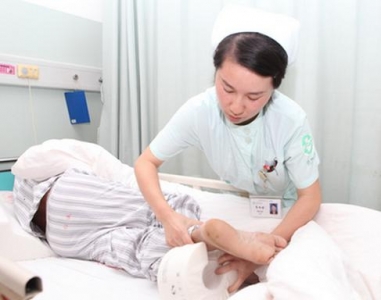美国国家压疮咨询委员会(NationalPressure Ulcer Advisory Panel ,NPUAP)公布了一项术语更改:之前的“压力性溃疡”(Pressure ulcer)更改为“压力性损伤”(Pressure injury),并且更新了压力性损伤的分期系统。
1468467387176387.jpg

在NPUAP公布的压力性损伤分期系统中,“压力性损伤”替代了“压力性溃疡”。这一更改更加准确地描述了完整或溃疡皮肤处的压力性损伤。在之前的分期系统中,1期和可疑深部组织损伤期用来描述完整的受损皮肤,其余分期描述开放性损伤皮肤。由于所有的分期都将损伤纳入了“压力性溃疡”的范畴,这导致了一些混淆。
除了术语的改变,新的分期系统中,阿拉伯数字替代了罗马数字,“可疑深部组织损伤”名称中去除了“可疑”二字。另外还增加了“医疗器械相关性压力性损伤”以及“粘膜压力性损伤”两个定义。
更新的分期和定义于2016年4月8-9日在芝加哥的专家会议上提出,此次会议有400名专家参会。来自弗吉尼亚大学的Grey教授引导分期小组及参会者在相互讨论与投票后达成一致。在会议上,参会者同时还以图片的形式确认了新的术语。
对压力性损伤进行分期可以表示组织损伤的程度,根据来自临床医务人员在诊断和识别压力性损伤分期过程中所遇到的问题,NPUAP修正了压力性损伤分期。
英文内容如下:
The updated staging system includes the following definitions:
Pressure Injury:
A pressure injury is localized damage to the skin and/or underlying
soft tissue usually over a bony prominence or related to a medical or otherdevice. The injury can present as intact skin or an open ulcer and may be painful. The injury occurs as a result of intense and/or prolonged pressure or pressure in combination with shear. The tolerance of soft tissue for pressureand shear may also be affected by microclimate, nutrition, perfusion, comorbidities and condition of the soft tissue.
Stage 1 Pressure Injury: Non-blanchable erythema of intact skin Intact skin with a localized area of non-blanchable erythema, which may appear differently in darkly pigmented skin. Presence of blanchable erythema or changes in sensation, temperature, or firmness may precede visual changes. Color changes do not include purple or maroon discoloration; these may indicate deep tissue pressure injury.
Stage 2 Pressure Injury: Partial-thickness skin loss with exposed dermis Partial-thickness loss of skin with exposed dermis. The wound bed is viable, pink or red, moist, and may also present as an intact or ruptured serum-filled blister. Adipose (fat) is not visible and deeper tissues are not visible. Granulation tissue, slough and eschar are not present. These injuries commonly result from adverse microclimate and shear in the skin over the pelvis and shear in the heel. This stage should not be used to describe moisture associated skin damage (MASD) including incontinence associated dermatitis (IAD), intertriginous dermatitis (ITD), medical adhesive related skin injury (MARSI), or traumatic wounds (skin tears, burns, abrasions).
Stage 3 Pressure Injury: Full-thickness skin loss Full-thickness loss of skin, in which adipose (fat) is visible in the ulcer and granulation tissue and epibole (rolled wound edges) are often present. Slough and/or eschar may be visible. The depth of tissue damage varies by anatomical location; areas of significant adiposity can develop deep wounds. Undermining and tunneling may occur. Fascia, muscle, tendon, ligament, cartilage and/or bone are not exposed. If slough or eschar obscures the extent of tissue loss this is an Unstageable Pressure Injury.
Stage 4 Pressure Injury: Full-thickness skin and tissue loss Full-thickness skin and tissue loss with exposed or directly palpable fascia, muscle, tendon, ligament, cartilage or bone in the ulcer. Slough and/or eschar may be visible. Epibole (rolled edges), undermining and/or tunneling often occur. Depth varies by anatomical location. If slough or eschar obscures the extent of tissue loss this is an Unstageable Pressure Injury.
Unstageable Pressure Injury: Obscured full-thickness skin and tissue loss Full-thickness skin and tissue loss in which the extent of tissue damage within the ulcer cannot be confirmed because it is obscured by slough or eschar. If slough or eschar is removed, a Stage 3 or Stage 4 pressure injury will be revealed. Stable eschar (i.e. dry, adherent, intact without erythema or fluctuance) on an ischemic limb or the heel(s) should not be removed.
Deep Tissue Pressure Injury: Persistent non-blanchable deep red, maroon or purple discoloration Intact or non-intact skin with localized area of persistent non-blanchable deep red, maroon, purple discoloration or epidermal separation revealing a dark wound bed or blood filled blister. Pain and temperature change often precede skin color changes. Discoloration may appear differently in darkly pigmented skin. This injury results from intense and/or prolonged pressure and shear forces at the bone-muscle interface. The wound may evolve rapidly to reveal the actual extent of tissue injury, or may resolve without tissue loss. If necrotic tissue, subcutaneous tissue, granulation tissue, fascia, muscle or other underlying structures are visible, this indicates a full thickness pressure injury (Unstageable, Stage 3 or Stage 4). Do not use DTPI to describe vascular, traumatic, neuropathic, or dermatologic conditions.
Additional pressure injury definitions.
Medical Device Related Pressure Injury:
This describes an etiology. Use the staging system to stage.
This describes the etiology of the injury. Medical device related pressure injuries result from the use of devices designed and applied for diagnostic or therapeutic purposes. The resultant pressure injury generally conforms to the pattern or shape of the device. The injury should be staged using the staging system.
Mucosal Membrane Pressure Injury: Mucosal membrane pressure injury is found on mucous membranes with a history of a medical device in use at the location of the injury. Due to the anatomy of the tissue these injuries cannot be staged.
(声明:文章转自造口伤口失禁微社区 转载仅供交流分享,如有侵权请告知)